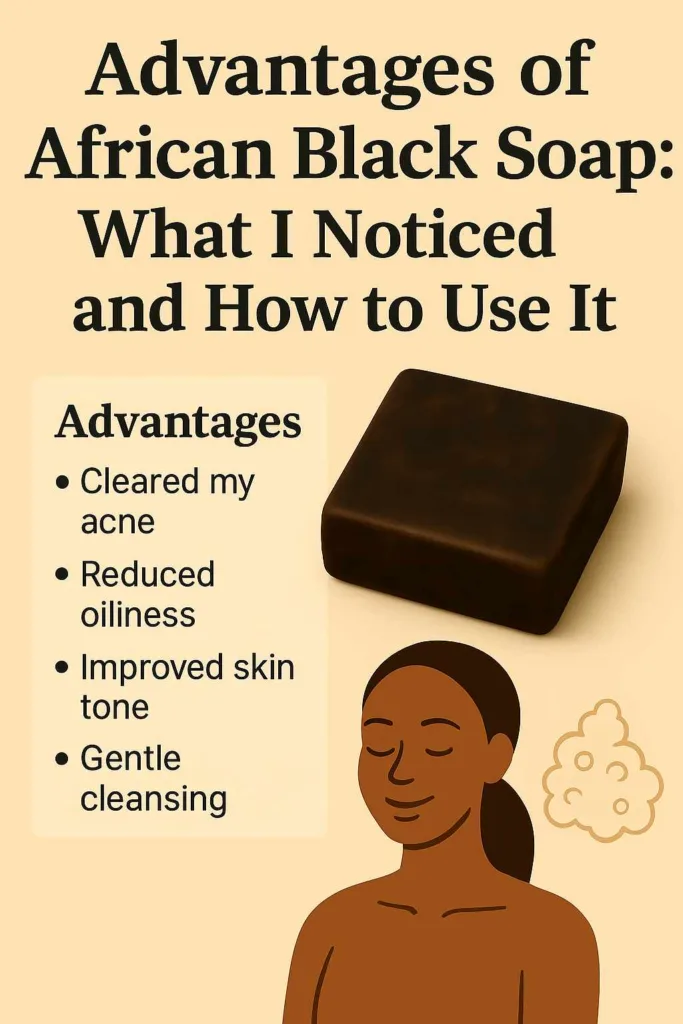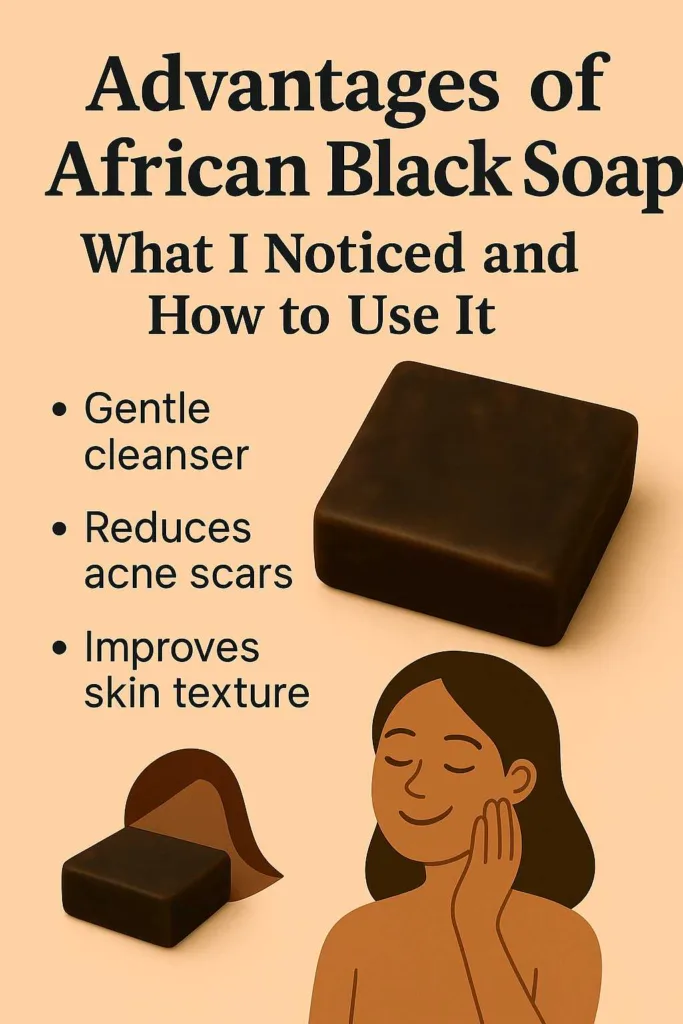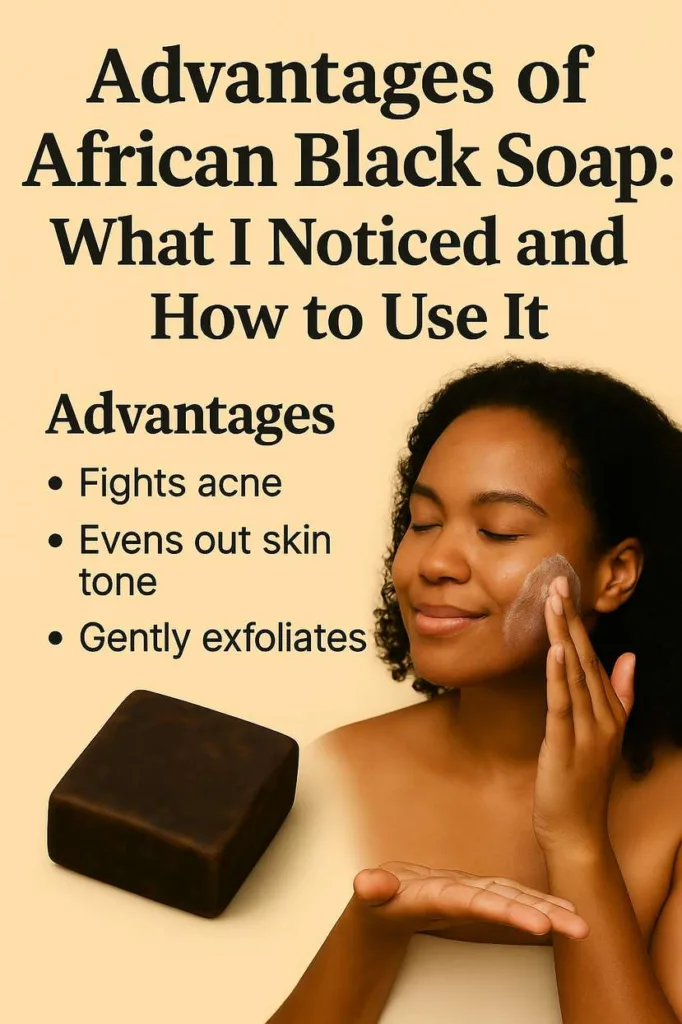Quick Take (Why I Tried It and What Happened)
After hearing countless beauty enthusiasts rave about this traditional cleanser, I decided to test African black soap for two weeks on my combination skin. The advantages of African black soap became apparent within days—my T-zone felt genuinely clean without that stripped, tight feeling I get from harsh cleansers. My occasional breakouts seemed to clear faster, and the natural exfoliation left my skin noticeably smoother. While it’s not a miracle cure, this unassuming bar delivered consistent results that made me understand why it’s been a skincare staple for centuries.

What Is African Black Soap, Really?
Traditional Ingredients & How It’s Made
Authentic African black soap originates from West Africa, particularly Ghana and Nigeria, where it’s called “ose dudu” or “alata samina.” The base starts with plantain peels, cocoa pods, or palm kernel shells that are sun-dried then burned to create potash-rich ash. This ash is mixed with water to form lye, which is then combined with natural oils like coconut, palm kernel, and shea butter. The mixture is hand-stirred for hours until it saponifies into a soft, clay-like texture that’s aged for weeks.
Authentic vs Fake: Texture, Scent, Color, and Label Clues
Real African black soap has an irregular, rustic appearance—think chunky, uneven texture with visible bits of plant matter. The color ranges from light tan to deep brown, rarely true black. It should feel soft and slightly crumbly, not hard like commercial soap bars. Authentic versions have a mild, earthy scent with hints of smokiness from the ash. Red flags include perfectly smooth bars, artificial fragrances, bright colors, or ingredient lists full of synthetic additives and sulfates.
The Advantages You Can Actually Feel
Deep-Yet-Squeaky Clean for Body and Scalp
The high potash content creates a naturally alkaline cleanser that cuts through oil, sweat, and buildup more effectively than many gentle cleansers. I noticed this especially on my scalp—after years of trying clarifying shampoos that left my hair stripped, African black soap removed product buildup while leaving my scalp feeling balanced. On my body, it tackled gym sweat and daily grime without requiring multiple washes or aggressive scrubbing.
Helps with Oil Control and Occasional Acne
The natural saponins and mild astringent properties help regulate sebum production without triggering the rebound oiliness I experience with harsh acne washes. During my testing period, my usual hormonal breakouts along my jawline cleared faster and seemed less inflamed. The soap’s antimicrobial properties, likely from the ash and coconut oil content, appeared to keep pore-clogging bacteria in check without completely disrupting my skin’s microbiome.
Gentle Natural Exfoliation
The fine ash particles provide mechanical exfoliation that’s gentler than scrubs but more effective than washcloths alone. Combined with the soap’s naturally high oleic acid content from shea butter and palm oils, this creates a unique cleansing experience that removes dead skin cells while maintaining moisture barrier function. My skin felt noticeably smoother after just three days of use, without the irritation I typically get from chemical exfoliants.
Value & Sustainability
A single bar costs $3-8 and lasts 2-3 months with daily use, making it incredibly economical compared to premium cleansers. The minimal packaging (usually just paper or no wrapping) and traditional production methods have a much smaller environmental footprint than conventional beauty products. Supporting authentic producers also helps preserve traditional craftsmanship and provides income to West African communities.

Where It Shines—and Where It Doesn’t
Face vs Body vs Scalp (What Worked Best for Me)
Body use was where African black soap truly excelled—it handled everything from post-workout sweat to stubborn sunscreen removal. On my scalp, it worked wonderfully as a clarifying treatment once or twice weekly. For facial use, I had mixed results. My oily T-zone loved it, but the delicate eye area and my occasionally sensitive cheeks preferred gentler options. I found diluting it significantly (creating a very light lather) made facial use more comfortable.
Hyperpigmentation: Realistic Expectations
While some claim African black soap fades dark spots, my experience was more modest. The gentle exfoliation may help with surface-level discoloration over time, but don’t expect dramatic lightening effects. Any improvements in skin tone I noticed were likely due to overall skin health rather than active brightening ingredients. For serious hyperpigmentation concerns, dedicated treatments with proven ingredients like vitamin C or retinoids remain more effective.
Eczema/Sensitive Skin: When to Be Cautious
The alkaline nature and potential fragrance compounds from natural plant matter can trigger reactions in sensitive individuals. If you have active eczema, rosacea, or compromised skin barrier, approach with extreme caution. The soap’s pH (typically 9-10) can disrupt already-vulnerable skin. I recommend consulting a dermatologist first if you have chronic skin conditions.
How to Use It Without Drying Your Skin
Patch Test, Lather-in-Hands, 30–60 Second Contact Time
Always patch test behind your ear or on your inner arm for 48 hours before full use. When ready to cleanse, work up lather in wet hands rather than applying the bar directly to skin—this dilutes the concentration and prevents over-cleansing. Apply the foam gently, leave for 30-60 seconds maximum, then rinse thoroughly with lukewarm water. This brief contact time allows the soap to work without stripping your acid mantle.
Follow with Hydrating Toner/Serum + Moisturizer
The alkaline pH means you’ll need to restore your skin’s natural acidity and moisture levels immediately after cleansing. I found a hydrating toner or essence essential within 60 seconds of washing, followed by a niacinamide serum and rich moisturizer. This routine prevented the tightness and flaking that can occur when African black soap is used alone.
Storage: Cut into Coins, Use a Draining Dish
African black soap dissolves quickly in humid environments, so proper storage is crucial. Cut your bar into smaller “coins” and store unused portions in a cool, dry place. Use a soap dish with drainage holes for daily pieces—the soap will turn mushy if left in standing water. Some users keep active pieces in the refrigerator to extend their life.
Side Effects & Safety
The most common issue is dryness and tightness, especially during the first week as your skin adjusts to the higher pH. Some people experience temporary purging where existing blackheads surface more quickly. The soap may sting on active breakouts due to its alkalinity. Those with fragrance sensitivities should be aware that even authentic, unscented versions contain natural aromatic compounds from the ash and oils. Pregnant women, people with severe skin conditions, or those using prescription topicals should consult a dermatologist before incorporating any new cleanser, especially one with such a different pH profile.
African Black Soap vs Other Cleansers (At a Glance)
| Feature | African Black Soap | Gentle Syndet Cleanser | Liquid Castile Soap |
| pH Level | 9-10 (alkaline) | 5.5-6.5 (skin-friendly) | 8.9-9.5 (alkaline) |
| Oil Control | Excellent | Moderate | Good |
| Exfoliation | Built-in (ash particles) | None | None |
| Moisture Retention | Low (needs follow-up) | High | Low |
| Ingredient Purity | High (traditional) | Variable | High |
| Cost per Use | Very low | Moderate | Low |
My 14-Day Mini Log (Template You Can Copy)
Day 1: Oiliness (1-10): ___ Tightness after cleansing: ___ New breakouts: ___ Notes: ___
Day 3: Oiliness: ___ Tightness: ___ Breakout changes: ___ Skin texture: ___
Day 7: Weekly check-in – Overall skin feel: ___ Dark spots: ___ Any irritation: ___
Day 10: Oiliness control: ___ Cleansing satisfaction: ___ Moisture needs: ___
Day 14: Final assessment – Would continue? ___ Best use areas (face/body/scalp): ___ Ideal frequency: ___
FAQs
Is it good for acne? Yes, for many people. The antimicrobial properties and oil control can help with bacterial acne, but hormonal acne may need additional treatments.
Can I use it every day? Start with 2-3 times weekly and increase gradually. Daily use works for some, but many find alternating with a gentler cleanser prevents over-drying.
Face or body? Body and scalp use tend to be most successful. Facial use requires more caution and proper follow-up hydration.
What’s the pH? Typically 9-10, which is significantly more alkaline than your skin’s natural 4.5-5.5 pH.
How to spot authentic soap? Look for irregular texture, natural color variations, minimal ingredients, and reputable sellers who can trace their source to West African producers.

Bottom Line
The advantages of African black soap are real but require realistic expectations and proper technique. This traditional cleanser excels at deep cleaning, natural exfoliation, and oil control while offering excellent value and sustainability. It works best for normal to oily skin types who can commit to the essential follow-up hydration routine. While it won’t replace targeted treatments for serious skin concerns, African black soap earns its place as a versatile, effective cleanser that connects you to centuries of skincare wisdom. Just remember: start slowly, moisturize religiously, and listen to your skin’s response.